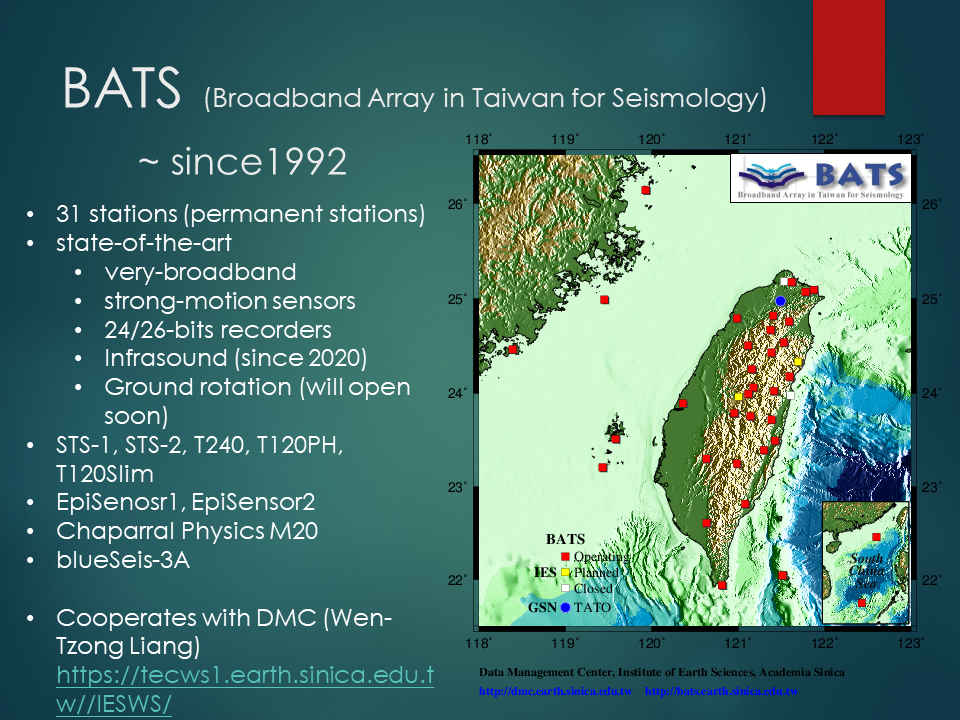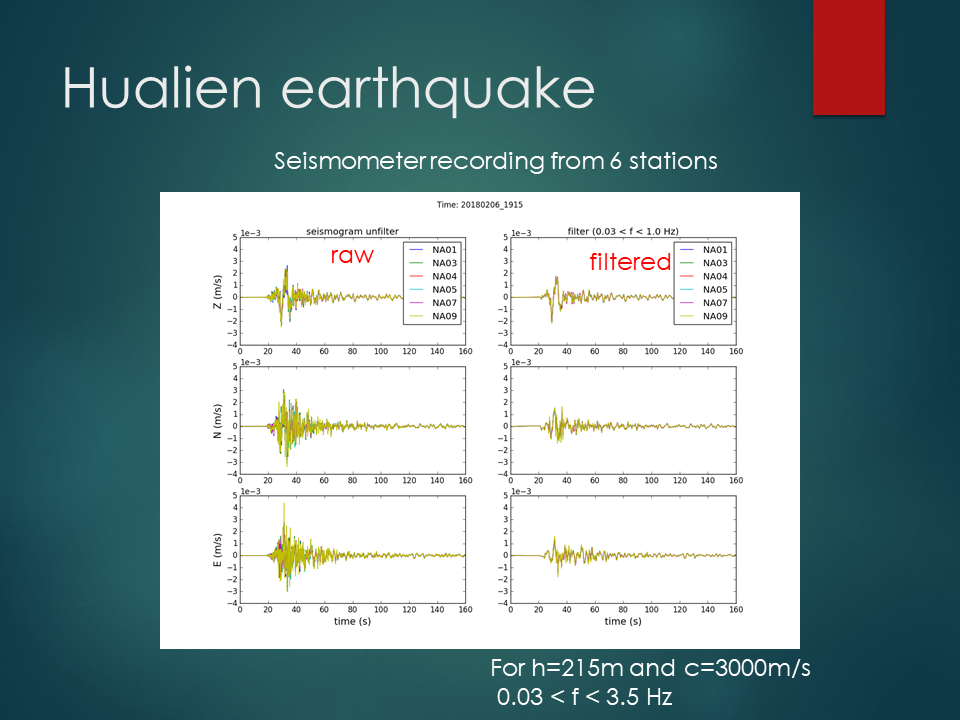
I lead a team called TSO (Technical Support Office) to provide technical service to Seismology, Geophysics, and Geochemistry Groups in IES. This team also provides key support for the operation of BATS (Broadband Array in Taiwan for Seismology)

In mid-1992, a broadband seismic network in the Taiwan region named "Broadband Array in Taiwan for Seismology (BATS)" was initially designed with stations located on Taiwan and the surrounding islands, covering an area of approximately 350 km by 400 km. Currently the number of permanent broadband stations operated by IES is 34, including 2 located in the South China Sea with satellite transmission.

In an environmentally controlled laboratory at the basement three in Institute of Earth Sciences, Academia Sinica, several facilities for calibration of seismic instrument are installed on the granite table. These facilities including APS shaking table, Aerotech rotation shaker, CT-EW1 calibration table, GNSS repeater, Q330 family seismic digitizer, Nanometrics Trillium 240 seismometer. Those are helpful for evaluation of frequency response of seismic sensor.

I manage the TEC (Taiwan Earthquake Research Center) instrument pool project to provide seismic instrument and technical service to scientific community in Taiwan.

Seismology is no longer based only on the analysis of observations made with classical seismometers measuring translational motions or their time derivatives. More and more observables such as strain, rotations, GPS-based measurements, and others are used to constrain either the Earth’s structure or to understand the nature of seismic sources and observed ground shaking. The analysis of rotational ground motions has recently emerged as a new branch in seismology and earthquake engineering. Rotational motions have several implications: 1) depending on frequency and amplitude range translational seismometer records are contaminated by rotational motions; 2) when both motion types (or additional strain measurements) are available the collocated records contain direct information on subsurface structure; 3) rotational motion observations can help in decomposing seismic wave fields; 4) inverse problems for structure and source may benefit from these additional observables.

IES invested one blueSeis-3A and installed it in Nanao Array in 2017. Nanao array situated in eastern Taiwan and is configured as 7‐element array. Right now we have a center station surrounded by two different size of triangle stations. The station spacing is around 110 m. It is unique in several ways: (1) it is designed to monitor both translational and rotational ground motions, (2) it quipped three infrasound sensors since Jan. 2018, and (3) it was motivated to study earthquake swarms. In 2017, this array installed three infrasound sensors together with seismometer and rotation sensor. Since then, it became a translation, rotation, and infrasound array for Seismology.

In February 6, 2018 a disaster earthquake (Mw 6.4) happens in Hualien city, around 50 Km away from Nanao array, was successfully recorded by Nanao array. By this chance, I took a great opportunity to study performance of blueSeis-3A through waveform comparison of ground rotation between array derivation and direct point measurement. The data used here is not from the main shock but after shock to avoid waveform saturation of broadband seismometer. The array waveform recordings are shown. These waveforms are hard to distinguish by eyes view as the array aperture is only 110 meters.

The array-derived rotation technique (Spudich and Fletcher 2008, Spudich et al. 1995) counts for the waveform amplitude/phase difference among station pairs. This process is so-called spatial derivation. In the end, the best fitted average ground rotation and strain among the array area is calculated. The three-component ground rotation waveform comparison between two different methodologies is shown. Point rotation is well consistent with array-derived rotation indicates that 1) uniform wavefield in array area; 2) well-controlled instrument; 3) dynamic strain can be estimated as well.

In observational seismology the long-period background noise level on seismometer horizontal components are always higher than the vertical component at the same location. It is believed that the horizontal long-period noise is mostly attributed to ground tilt, yet the authentic tilt recordings of background noise at seismic frequency band had not been recorded successfully. To demonstrate this concept, we install a newly developed optical based rotation sensor blueSeis-3A at a station with horizontal long-period (1 < T < 100 s) background noise level higher than global New High-Noise Model (NHNM), where a seismometer and a tiltmeter are collocated. We firstly found a known fact that the horizontal recordings from a tiltmeter and a seismometer are visually consistent. It becomes clear until ground tilt recorded by a rotation sensor are found to be waveform matched with them, indicating both sensors are contaminated by tilt. Based on the spectrum of tilt records, it shows ground tilts are mostly at period bands > 1 s. By subtracting tilt from seismometer records, the horizontal background noise levels can be improved, approximately to the resolution level of rotation sensors. Our results demonstrate that collocating rotational sensors with seismometers is a feasible way to improve the quality of long-period background noise level on seismometer horizontal components when rotational sensors are sufficiently sensitive.

Nowadays, observing infrasound signals from both natural and manmade sources gain more attentions, e.g., volcano eruption, tornado warning, seismic-acoustic interaction, nuclear explosion.

The main difficulty in infrasound observation goes to the environmental wind noise. Infrasonic noise increases at all frequencies with increasing wind speed. Design a wind filter to preserve signals of interest at certain frequency band while attenuate wind noise is the key to the infrasound research. Since 2019, we installed more than 16 infrasound sensor at BATS. These stations will equip new design of wind filter, the PVC tube housing. The advantages of this new design wind filter compared with the rosette pipe array (2m in diameter) are lower cost, easier installation, better security, less space. There is only little difference on performance between them.

